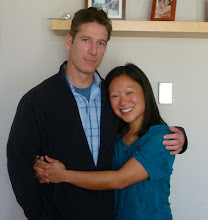 Crossing the Marsyangdi on our way to Upper Pisang.
Crossing the Marsyangdi on our way to Upper Pisang.
 Steve and the Swarga Dhar
Steve and the Swarga Dhar
We are yet to see our first yak or nak, but Robyn claims to have see a yeti earlier today. I informed her that this wasn't possible, as the yeti resides in the high Himalaya, not down here at 10,000 ft. She clarified her sighting suggesting instead that I'm starting to look more like a yeti by the day. Today's climb took us through some of the most beautiful country so far. We followed a deep river gorge up through richly scented pine forest, an inspiring passage cut into the rock face pst a 5,000 ft high slab of rock called the Swarga Dhar (Gateway to Heaven). Nepalis believe that the spirit of the deceased has to climb up and over this rock to reach the afterlife. After a lunch of tuna spaghetti (one of the food options with protein in it) and Masala tea (so good), we continued upwards to where the steep canyon opened into an impressive valley on the Northeast side of the Annapurna massif. We have finally turned the corner (literally) and are now in the rain shadow of the mountains, and hopefully leaving the rain and clouds behind. We are perched at the Himalayan Guesthouse in Upper Pisang. Our room looks south across the valley towards the Annapurnas. If the clouds vanish tomorrow, we are in for our first spectacular views of Annapurna 3 and 4.
I think the thin air is making us a little kooky or it could be the lack of things to do after dinner, but we wrote a few little diddies/songs of our experiences to pass the time:
Sleeping in the CloudsHigh in the Himalaya
Lies a stone house
Just below a Buddhist monastery
The chanting whips in with the wind
I'm sleeping in the Himalaya
High up in the clouds
Feeling at ease
dreaming of yaks and yetis
Prayer flags blowing
in the breeze
The yeti riding the yak
Tuna spaghetti & mac
A yeti is white not black
Watch out for dal bhal attack
Nakkety nak a female yak.
The Dark Side of the HimalayaDelayed and terrified by a landslide
Stumbled over slipppery stones
On a trail that looks like a stream
The cold chilling us to the bone
My blood sustaining a leech
Duped by a guide
Nursing blisters all the way
Climbing, climbing, climbing
Slapped by a donkey
Slipped on his dung
Scooted under a waterfall
Scratched my thumb
Bit by a horsefly
Stung by a nettle
Trying to save money boiling tea in a kettle
Peed myself
Got gassed by dal bhat
Our alarm clock wakes us up at 7am to a robot
Spending $35 a day for all this
When deep down it's Kata Beach that we miss.
 Sunset at our surf point. This is taken at low tide, making this break a little treacherous to surf even at a high tide with the rocky bottom. I lost a fin our first day out.
Sunset at our surf point. This is taken at low tide, making this break a little treacherous to surf even at a high tide with the rocky bottom. I lost a fin our first day out.









































